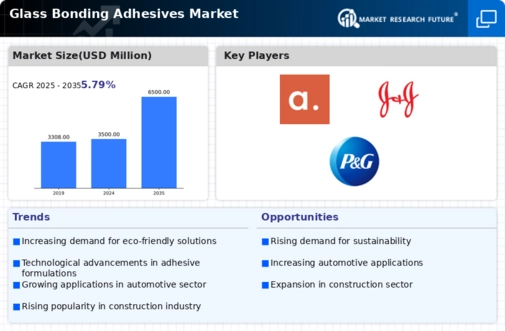Glass Bonding Adhesives Size
Glass Bonding Adhesives Market Growth Projections and Opportunities
The Glass Bonding Adhesives Market is significantly influenced by various market factors that collectively shape its dynamics. One of the primary factors driving the market is the increasing demand for glass bonding adhesives across diverse industries. With the rising use of glass in construction, automotive, electronics, and other applications, the need for reliable and efficient bonding solutions has surged. This trend is particularly evident in the automotive sector, where lightweight glass materials are increasingly employed to enhance fuel efficiency and overall vehicle performance. Glass Bonding Adhesives Market is expected to grow at Significant CAGR from 2021-2030 as per MRFR Analysis
Another crucial market factor is the continual advancements in adhesive technologies. Manufacturers are constantly investing in research and development to formulate adhesives with improved bonding capabilities, durability, and resistance to environmental factors. These technological innovations contribute to the overall growth of the glass bonding adhesives market, enabling the adhesive products to meet evolving industry requirements and standards.
Global economic conditions also play a vital role in shaping the glass bonding adhesives market landscape. Economic stability and growth impact the construction and automotive industries, two major consumers of glass bonding adhesives. A robust economy often leads to increased construction activities, driving the demand for glass bonding adhesives in architectural applications. Similarly, economic growth is associated with higher consumer spending, positively influencing the automotive sector and subsequently boosting the demand for glass bonding adhesives in vehicle manufacturing.
Moreover, environmental concerns and regulatory standards are becoming increasingly influential factors in the glass bonding adhesives market. As sustainability becomes a focal point across industries, there is a growing emphasis on eco-friendly and low-VOC (volatile organic compound) adhesive solutions. Manufacturers are responding to these concerns by developing adhesive products that comply with environmental regulations, providing both efficient bonding solutions and reduced environmental impact. This shift towards sustainable practices not only aligns with global initiatives but also opens up new market opportunities for environmentally friendly glass bonding adhesives.
The competitive landscape and market consolidation also contribute to the market dynamics of glass bonding adhesives. The presence of key players in the industry, engaged in mergers, acquisitions, and strategic partnerships, significantly influences market trends. These activities often lead to the expansion of product portfolios, geographical reach, and technological capabilities, ultimately shaping the overall competitiveness of the market.
Furthermore, the end-user industries' specific requirements and trends have a direct impact on the glass bonding adhesives market. For instance, the growing popularity of electric vehicles (EVs) has created a demand for specialized adhesives capable of bonding lightweight glass components in electric vehicle manufacturing. Similarly, the increasing focus on energy-efficient buildings has driven the need for advanced glass bonding adhesives in the construction sector, catering to the specific requirements of energy-efficient glass installations.







Leave a Comment